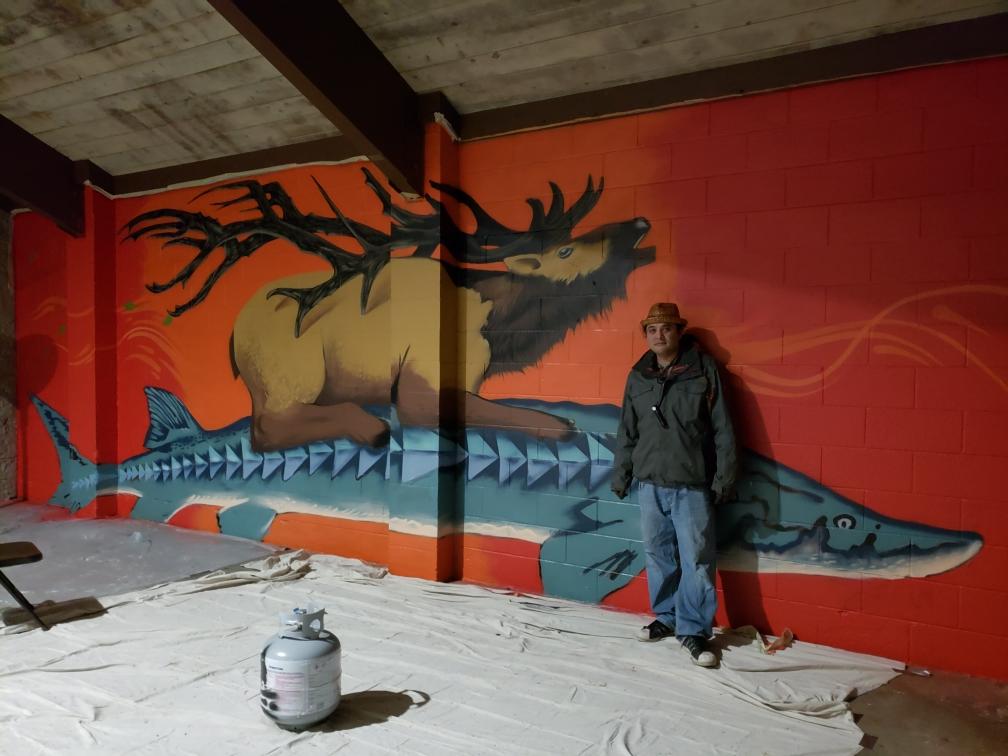Overview: What is a Talking Wall?
At Color Outside the Lines, we believe that public art brings communities closer together and cultivates curiosity about the places we inhabit. We teamed up with Tualatin Hills Park & Recreation District to create a series of “Talking Walls” throughout parks, schools, and other public areas in and around Beaverton. A Talking Wall is a form of visual storytelling and placemaking that transforms a blank public wallspace into a vibrant anchor for public conversation, hope, and healing. The objective of these spaces is to provide a source of inspiration and education for community visitors.
Storytelling Highlighting Native American Artists and Culture
In the winter of 2021, Color Outside the Lines joined with three Native American artists based in the Pacific Northwest to create a series of collaborative “Talking Walls.” These murals aimed to celebrate the vibrant diversity of Indigenous cultures, while sharing traditional art and storytelling with Native youth and the broader community. By creating the murals in public spaces, the project aimed to demonstrate how Native American art is something that everyone can enjoy and appreciate, regardless of their cultural or racial background. Youth from the Native American Youth Association and the local community at Greenway Park in Beaverton participated in the event, which took place over a weekend in February.
Each artist designed and directed the production of a mural that reflected their particular Native heritage and culture. The event connected youth with artists of similar backgrounds, offering an opportunity for conversation about their shared Indigenous heritage. During the event, the artists shared stories that inspired their artworks. Later, these stories were written on plaques and installed beside the murals so that the local community could continue to learn about the underlying meaning of each piece.
COTL distributed art kits to all the youth who participated and facilitated other art enrichment activities. In addition to painting the murals, youth also created spirit sticks and painted rocks that were installed in a garden nearby.
The Talking Walls mural project was held in partnership with the Tualatin Hills Park & Recreation District.
Redstone Rudy Serna
Redstone Rudy Serna is originally from the Huichol and Guachichile Tribes of Mexico and now lives in Portland, OR.

Redstone’s mural is meant to honor and respect the ancestors of the Americas by highlighting elements of their diverse, yet common culture. The mural incorporates patterns from Incan, Mayan, and Aztec traditions, as well as important Indigenous imagery, including a pyramid from the Guatemalan lowlands, the Mexican symbol for corn, a teepee, and woven baskets from the Chinook and Kalapuya tribes. Animals integral to Indigenous tradition are depicted throughout the painting: the South American condor, the quetzal bird, a buffalo skull, a salmon adorned with an Inuit pattern, the American bald eagle, and a lone wolf howling. Finally, with a smattering of Evergreens from the Columbia Gorge, the mural pays homage to its placement in the Pacific Northwest.

Pattrick Price
Pattrick Price (Kaá Yaán Uk) was born and raised in Southeast Alaska. He is a member of the Tlingit tribe, who are from the islands and fjords of Southeast Alaska. Now based in Eugene, Pattrick works as a painter, muralist, and Native American storyteller, creating work that reflects his Indigenous background.
Pattricks’s mural depicts a brilliant, multi-colored hummingbird with an arching red, orange, and yellow gradient background. He shared the following words to describe his painting:
“In Native American culture, hummingbirds are regarded as healers and harbingers of love, good luck, and joy. The hummingbird totem has been used in my culture throughout history to teach us to enjoy life, and to keep ourselves light and free. This painting is my depiction of the original line designs from my Southeast Alaska/Tlingit heritage with warm and colorful inspirations from my residence in Oregon in the fall season.”
Toma Villa
Toma Villa is a muralist, painter, carver, and sculptor from the Yakama Nation, currently residing north of Seattle. His painting depicts an elk riding on the back of a sturgeon.

Toma shared the following words about his mural:
“The painting is about an Elk and how he wanders the land over and over again, eventually making his way back to the Big River and yearning to explore the other side. He looks into the water and sees all the salmon swimming and thinks he can walk across on their backs but his hooves keep sliding off and he falls into the water. Sturgeon sees this and swims up and asks Elk what he's doing. Elk replies, “I've seen everything on this side of the river, I want to see what's on the other side.” Sturgeon tells Elk that she can get him across on her back but needs something from Elk for the ride across the river. Elk pulls a piece of himself and gives it to Sturgeon and the big fish puts it in her mouth. Elk climbs on his back and doesn't fall off because Sturgeon's skin is rough. So Sturgeon with Elk on her back began swimming across the river and as she swam that piece of Elk that was in her mouth became her cheeks. Elk made it across and was able to continue exploring and Sturgeon now has stronger muscles to help her feed more on the freshwater clams she so dearly loves.”






